
STOP 5 - TRIP TWO
( Next Stop) ( Previous Stop) ( Index Map) ( Trip 2 Home) ( Trip 1 Home)
Juniata/Tuscarora - Late Ordovician, Early Silurian
Geology 364 - Stratigraphy and Basin Analysis
Dept. of Geology and Environmental Studies
James Madison University
Lynn S. Fichter
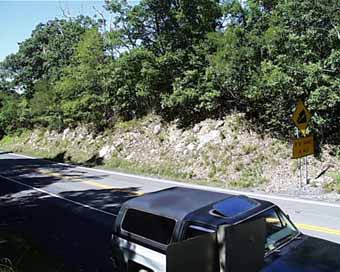 As I said when we got to this stop, this is one of the worst outcrops I know of the Juniata and Tuscarora formtions, and the contact that is here has been erased by the small access road. But, it is convenient. Germany Valley has exposures so superlative to this one that I wish we could visit it instead (and we do in Geol 230). I have included below pictures from the Germany Valley outcrops because even for just pictures you can see more than we did at this outcrop.
As I said when we got to this stop, this is one of the worst outcrops I know of the Juniata and Tuscarora formtions, and the contact that is here has been erased by the small access road. But, it is convenient. Germany Valley has exposures so superlative to this one that I wish we could visit it instead (and we do in Geol 230). I have included below pictures from the Germany Valley outcrops because even for just pictures you can see more than we did at this outcrop.
But what you did see here was that the Juniata was a thick, interbedded red sandstone and shale. The sandstone is virtually a quartz arenite, except for the red stain. We also some some cross bedding (trough, although planar is present at other locations), red mud pebbles, and a few "Scolithus".
|
 The second picture down, as well as the close-up below, is the Tuscarora. It is an extremely mature quartz arenite with rounded, well sorted, frosted grains (which gives it its brilliant white color). There was also "Scolithus" at this outcrop. At Germany Valley a lot of cross bedding and other structures typical of a beach/near shore system are common.
The second picture down, as well as the close-up below, is the Tuscarora. It is an extremely mature quartz arenite with rounded, well sorted, frosted grains (which gives it its brilliant white color). There was also "Scolithus" at this outcrop. At Germany Valley a lot of cross bedding and other structures typical of a beach/near shore system are common.
|
Germany Valley Juniata/Tuscarora
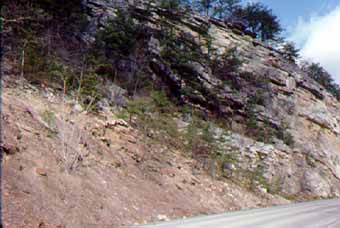 Where we visit the Juniata-Tuscarora at Great North Mountain is not the best place to see these formations, but you can't get all the good stops in just two days.
Where we visit the Juniata-Tuscarora at Great North Mountain is not the best place to see these formations, but you can't get all the good stops in just two days.
Actually, we see excellent exposures on the last Geol 230 field trip at Germany Valley, so the pictures here are either to: (1) spark your memory, or (2) give you a somewhat better sense of what these formations contain. We begin with the contact, and then look at each formation separately.
To the right we are looking up section from the red Juniata toward the white Tuscarora. The two pictures below are other views of the contact. The contact is distict, but not abrupt. It takes place over about 10-15 feet of section. The sandstones go from being distinctly mud red, to pink stained, to pure white. Likewise the shales fade in their redness, before disappearing completely. "Scolithus" is common in the transition zone.
|
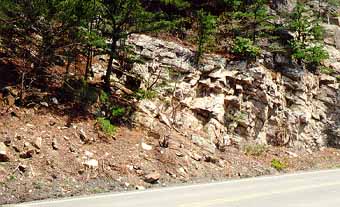

|
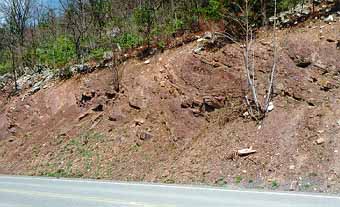 This is the top of the Juniata, about 30 meters below the Tuscarora contact. Here it is interbedded red (wacke) quartz sandstones and shales. The sandstones are cross bedded.
This is the top of the Juniata, about 30 meters below the Tuscarora contact. Here it is interbedded red (wacke) quartz sandstones and shales. The sandstones are cross bedded.
|
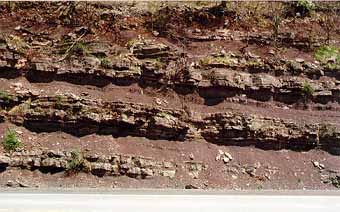 This outcrop is on the other side of the mountain, near the bottom of the formation, just above the Oswego contact. Here the Juniata has its most distinctive appearance, a fining/thinning upward sequence of sandstones that grade into mudstones; the whole thing cycling over and over. The sandstones typically have large planar and trough cross beds.
This outcrop is on the other side of the mountain, near the bottom of the formation, just above the Oswego contact. Here the Juniata has its most distinctive appearance, a fining/thinning upward sequence of sandstones that grade into mudstones; the whole thing cycling over and over. The sandstones typically have large planar and trough cross beds.
"Scolithus" traces are often found in the sandstones, and "Lingula" traces in the mudstones. "Scolithus" likes relatively clean, near shore sandstones, and "Lingula" today lives in tidal mud flats. (These two organisms are closely related, by the way.) All of the facies elements point to a tidal environment. The cycle we see here is very typical of tidal parasequences.
|
The Tuscarora is a supermature quartz arenite, the most mature sandstone I have ever seen. The grains are often rounded to subrounded, very well sorted, and commonly frosted (giving the rock it white appearance.) We saw these featues at Great North Mountain, as well as some "Scolithus" but most of the other features are better exposed at Germany Valley (the two pictures below).
Here the Tuscarora has many features of a beach/strand system, large cross bedded sand bars, parallel laminated swash zones, very fine grained wind blown sands, and lagoons with black shales and abundant trace fossils.
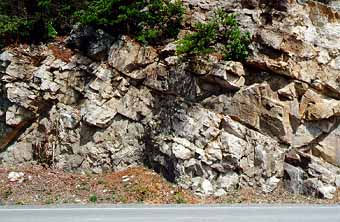 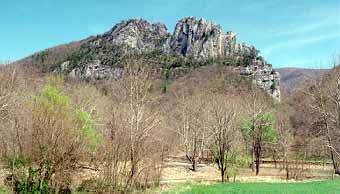
The Tuscarora is also well indurated (quartz cement) making it very resistant. It is a ridge former most places it is found, such as Seneca rocks above right, and the Great North Mountain outcrop we visited.
|
|

 As I said when we got to this stop, this is one of the worst outcrops I know of the Juniata and Tuscarora formtions, and the contact that is here has been erased by the small access road. But, it is convenient. Germany Valley has exposures so superlative to this one that I wish we could visit it instead (and we do in Geol 230). I have included below pictures from the Germany Valley outcrops because even for just pictures you can see more than we did at this outcrop.
As I said when we got to this stop, this is one of the worst outcrops I know of the Juniata and Tuscarora formtions, and the contact that is here has been erased by the small access road. But, it is convenient. Germany Valley has exposures so superlative to this one that I wish we could visit it instead (and we do in Geol 230). I have included below pictures from the Germany Valley outcrops because even for just pictures you can see more than we did at this outcrop.  The second picture down, as well as the close-up below, is the Tuscarora. It is an extremely mature quartz arenite with rounded, well sorted, frosted grains (which gives it its brilliant white color). There was also "Scolithus" at this outcrop. At Germany Valley a lot of cross bedding and other structures typical of a beach/near shore system are common.
The second picture down, as well as the close-up below, is the Tuscarora. It is an extremely mature quartz arenite with rounded, well sorted, frosted grains (which gives it its brilliant white color). There was also "Scolithus" at this outcrop. At Germany Valley a lot of cross bedding and other structures typical of a beach/near shore system are common.